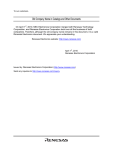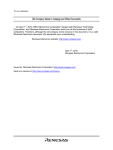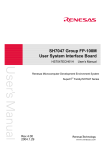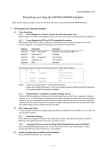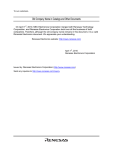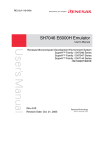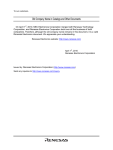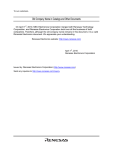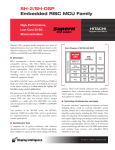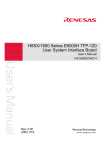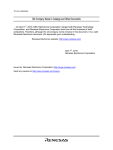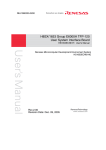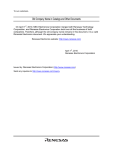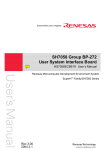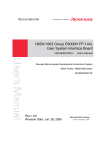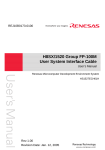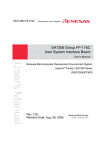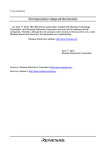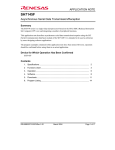Download Renesas FP-144F User's Manual
Transcript
SH7145 Group FP-144F User System Interface Board HS7145ECH61H User’s Manual Renesas Microcomputer Development Environment System SuperHTM Family/SH7144 Series Rev.4.00 2004.1.29 Cautions Keep safety first in your circuit designs! 1. Renesas Technology Corp. puts the maximum effort into making semiconductor products better and more reliable, but there is always the possibility that trouble may occur with them. Trouble with semiconductors may lead to personal injury, fire or property damage. Remember to give due consideration to safety when making your circuit designs, with appropriate measures such as (i) placement of substitutive, auxiliary circuits, (ii) use of nonflammable material or (iii) prevention against any malfunction or mishap. Notes regarding these materials 1. These materials are intended as a reference to assist our customers in the selection of the Renesas Technology Corp. product best suited to the customer's application; they do not convey any license under any intellectual property rights, or any other rights, belonging to Renesas Technology Corp. or a third party. 2. Renesas Technology Corp. assumes no responsibility for any damage, or infringement of any third-party's rights, originating in the use of any product data, diagrams, charts, programs, algorithms, or circuit application examples contained in these materials. 3. All information contained in these materials, including product data, diagrams, charts, programs and algorithms represents information on products at the time of publication of these materials, and are subject to change by Renesas Technology Corp. without notice due to product improvements or other reasons. It is therefore recommended that customers contact Renesas Technology Corp. or an authorized Renesas Technology Corp. product distributor for the latest product information before purchasing a product listed herein. The information described here may contain technical inaccuracies or typographical errors. Renesas Technology Corp. assumes no responsibility for any damage, liability, or other loss rising from these inaccuracies or errors. Please also pay attention to information published by Renesas Technology Corp. by various means, including the Renesas Technology Corp. Semiconductor home page (http://www.renesas.com). 4. When using any or all of the information contained in these materials, including product data, diagrams, charts, programs, and algorithms, please be sure to evaluate all information as a total system before making a final decision on the applicability of the information and products. Renesas Technology Corp. assumes no responsibility for any damage, liability or other loss resulting from the information contained herein. 5. Renesas Technology Corp. semiconductors are not designed or manufactured for use in a device or system that is used under circumstances in which human life is potentially at stake. Please contact Renesas Technology Corp. or an authorized Renesas Technology Corp. product distributor when considering the use of a product contained herein for any specific purposes, such as apparatus or systems for transportation, vehicular, medical, aerospace, nuclear, or undersea repeater use. 6. The prior written approval of Renesas Technology Corp. is necessary to reprint or reproduce in whole or in part these materials. 7. If these products or technologies are subject to the Japanese export control restrictions, they must be exported under a license from the Japanese government and cannot be imported into a country other than the approved destination. Any diversion or reexport contrary to the export control laws and regulations of Japan and/or the country of destination is prohibited. 8. Please contact Renesas Technology Corp. for further details on these materials or the products contained therein. IMPORTANT INFORMATION READ FIRST • READ this user's manual before using this user system interface cable. • KEEP the user's manual handy for future reference. Do not attempt to use the user system interface cable until you fully understand its mechanism. User System Interface Cable: Throughout this document, the term "user system interface cable" shall be defined as the following product produced only by Renesas Technology Corp. excluding all subsidiary products. • User system interface cable (HS7145ECH61H) The user system or a host computer is not included in this definition. Purpose of the User System Interface Cable: This user system interface cable is for connecting the evaluation chip board and user system. This user system interface cable must only be used for the above purpose. Improvement Policy: Renesas Technology Corp. (including its subsidiaries, hereafter collectively referred to as Renesas) pursues a policy of continuing improvement in design, performance, functions, and safety of the user system interface cable. Renesas reserves the right to change, wholly or partially, the specifications, design, user's manual, and other documentation at any time without notice. Target User of the User System Interface Cable: This user system interface cable should only be used by those who have carefully read and thoroughly understood the information and restrictions contained in the user's manual. Do not attempt to use the user system interface cable until you fully understand its mechanism. It is highly recommended that first-time users be instructed by users that are well versed in the operation of the user system interface cable. I LIMITED WARRANTY Renesas warrants its user system interface cables to be manufactured in accordance with published specifications and free from defects in material and/or workmanship. Renesas will repair or replace any user system interface cables determined to be defective in material and/or workmanship. User system interface cables are wearing parts which Renesas will not repair or replace if damaged and/or worn through use. The foregoing shall constitute the sole remedy for any breach of Renesas’ warranty. This warranty extends only to you, the original Purchaser. It is not transferable to anyone who subsequently purchases the user system interface cable from you. Renesas is not liable for any claim made by a third party or made by you for a third party. DISCLAIMER RENESAS MAKES NO WARRANTIES, EITHER EXPRESS OR IMPLIED, ORAL OR WRITTEN, EXCEPT AS PROVIDED HEREIN, INCLUDING WITHOUT LIMITATION THEREOF, WARRANTIES AS TO MARKETABILITY, MERCHANTABILITY, FITNESS FOR ANY PARTICULAR PURPOSE OR USE, OR AGAINST INFRINGEMENT OF ANY PATENT. IN NO EVENT SHALL RENESAS BE LIABLE FOR ANY DIRECT, INCIDENTAL OR CONSEQUENTIAL DAMAGES OF ANY NATURE, OR LOSSES OR EXPENSES RESULTING FROM ANY DEFECTIVE USER SYSTEM INTERFACE CABLE, THE USE OF ANY USER SYSTEM INTERFACE CABLE, OR ITS DOCUMENTATION, EVEN IF ADVISED OF THE POSSIBILITY OF SUCH DAMAGES. EXCEPT AS EXPRESSLY STATED OTHERWISE IN THIS WARRANTY, THIS USER SYSTEM INTERFACE CABLE IS SOLD "AS IS ", AND YOU MUST ASSUME ALL RISK FOR THE USE AND RESULTS OBTAINED FROM THE USER SYSTEM INTERFACE CABLE. II State Law: Some states do not allow the exclusion or limitation of implied warranties or liability for incidental or consequential damages, so the above limitation or exclusion may not apply to you. This warranty gives you specific legal rights, and you may have other rights which may vary from state to state. The Warranty is Void in the Following Cases: Renesas shall have no liability or legal responsibility for any problems caused by misuse, abuse, misapplication, neglect, improper handling, installation, repair or modifications of the user system interface cable without Renesas’ prior written consent or any problems caused by the user system. All Rights Reserved: This user's manual and user system interface cable are copyrighted and all rights are reserved by Renesas. No part of this user's manual, all or part, may be reproduced or duplicated in any form, in hard-copy or machine-readable form, by any means available without Renesas’ prior written consent. Other Important Things to Keep in Mind: 1. Circuitry and other examples described herein are meant merely to indicate the characteristics and performance of Renesas’ semiconductor products. Renesas assumes no responsibility for any intellectual property claims or other problems that may result from applications based on the examples described herein. 2. No license is granted by implication or otherwise under any patents or other rights of any third party or Renesas. Figures: Some figures in this user's manual may show items different from your actual system. Limited Anticipation of Danger: Renesas cannot anticipate every possible circumstance that might involve a potential hazard. The warnings in this user's manual and on the user system interface cable are therefore not all inclusive. Therefore, you must use the user system interface cable safely at your own risk. III SAFETY PAGE READ FIRST • READ this user's manual before using this user system interface cable. • KEEP the user's manual handy for future reference. Do not attempt to use the user system interface cable until you fully understand its mechanism. DEFINITION OF SIGNAL WORDS This is the safety alert symbol. It is used to alert you to potential personal injury hazards. Obey all safety messages that follow this symbol to avoid possible injury or death. DANGER WARNING CAUTION CAUTION DANGER indicates an imminently hazardous situation which, if not avoided, will result in death or serious injury. WARNING indicates a potentially hazardous situation which, if not avoided, could result in death or serious injury. CAUTION indicates a potentially hazardous situation which, if not avoided, may result in minor or moderate injury. CAUTION used without the safety alert symbol indicates a potentially hazardous situation which, if not avoided, may result in property damage. NOTE emphasizes essential information. IV WARNING Observe the precautions listed below. Failure to do so will result in a FIRE HAZARD and will damage the user system and the emulator product or will result in PERSONAL INJURY. The USER PROGRAM will be LOST. 1. Do not repair or remodel the emulator product by yourself for electric shock prevention and quality assurance. 2. Always switch OFF the E6000H emulator and user system before connecting or disconnecting any CABLES or PARTS. 3. Always before connecting any CABLES, make sure that pin 1 on both sides are correctly aligned. V Preface The HS7145ECH61H is a user system interface board that connects a user system for the SH7145 FP-144F package to the SH7046 E6000H emulator (HS7046EPH60H). i Contents Section 1 Configuration.....................................................................................1 Section 2 Environmental Conditions.................................................................3 2.1 Setting Operating Voltage and Operating Frequency ....................................................... 3 Section 3 Product Specifications .......................................................................4 Drop in Vcc Level Detection Function: ............................................................................ 4 Section 4 User Interface Specifications .............................................................5 4.1 User System Interface Circuit ........................................................................................... 5 Section 5 Connection Procedures ......................................................................8 5.1 5.2 5.3 5.4 5.5 Connecting User System Interface Board to User System ................................................ 8 5.1.1 Installing IC Socket.............................................................................................. 8 5.1.2 Installing Cable Head........................................................................................... 9 5.1.3 Fastening Cable Head .......................................................................................... 9 Connecting User System Interface Board to EV-Chip Board ........................................... 11 Recommended Dimensions for User System Mount Pad (Footprint) ............................... 13 Dimensions for EV-Chip Board and User System Interface Board................................... 14 Resulting Dimensions after Connecting User System Interface Board ............................. 15 Section 6 Installing the MCU to the User System .............................................16 Section 7 Verifying Operation...........................................................................18 Section 8 Notice.................................................................................................20 ii Section 1 Configuration Figure 1 and table 1 show the configuration and components of the user system interface board for the FP-144F package. Please make sure you have all of these components when unpacking. EV-chip board Screws (M2.0 x 6 mm) Screws (M2.0 x 10 mm) Board Socket cover Spacer IC socket User system Figure 1 User System Interface Board for the SH7145 FP-144F Package 1 CAUTION Use a NQPACK144SD socket (manufactured by Tokyo Eletech Corporation) for the FP-144F package IC socket on the user system. Table 1 HS7145ECH61H Components No. Component Quantity Remarks 1 Board 1 With two spacers (2.6MP x 6 mm) 2 IC socket 1 For the FP-144F package (to be mounted on the user system) 3 Socket cover 1 For the FP-144F package (for installing MCU) 4 Screws (M2.0 x 10 mm) 4 For fastening board 5 Screws (M2.0 x 6 mm) 4 For installing an FP-144F-packaged MCU 6 Guide pins 3 7 Screwdriver 1 8 User’s manual 1 2 User’s manual for HS7145ECH61H (this manual) Section 2 Environmental Conditions Maintain the conditions in table 2 when using the emulator. Table 2 Environmental Conditions Item Specifications Temperature Operating: +10 to +35°C Storage: -10 to +35°C Humidity Operating: 35 to 80% RH, no condensation Storage: 35 to 80% RH, no condensation Vibration Operating: 2.45 m/s max. Storage: 4.9 m/s max. Transportation: 14.7 m/s max. Ambient gases There must be no corrosive gases present. 2.1 Setting Operating Voltage and Operating Frequency Connecting the user system interface board to the SH7046 series E6000H emulator enables emulation to be done using the user system operating voltage (Vcc: 3.0 to 3.6 V) Before determining the operating voltage and frequency of the user system, confirm the allowable range. Vcc (V) 3.6 Operating voltage 3.0 0 4.0 Operating frequency 50.0 (MHz) : Range which can be emulated Figure 2 Allowable Operating Range 3 Section 3 Product Specifications The specifications of this product are shown in table 3. Table 3 Product Specifications Item Specifications Target processor SH7145F Package FP-144F Function Level limitation: This function keeps the output signal from 3-V emulator system equal to or less than power supply voltage of the user system (Vcc). User-system operating conditions Power supply voltage Vcc: 3.0 to 3.6 V A drop in the Vcc level of the user system is detected when the power supply voltage drops to 2.6 V or less. Current consumption Maximum of 100 mA. Drop in Vcc Level Detection Function: When the user system interface board is used, a drop is detected as follows: When the power supply voltage (UVcc) of the user system is 2.6 V or less, the HEW will detect a Vcc drop. In this case, a sufficient voltage may not be supplied to the user system; ensure that the specified value of the power supply voltage is supplied. 4 Section 4 User Interface Specifications The user system interface board incorporates a level conversion circuit supporting a low-voltage circuit. Accordingly, when connecting the user system to the emulator, pay attention to the signal delays and the number of FANINs and FANOUTs. 4.1 User System Interface Circuit The user system interface circuit of the user system interface board is shown below. (1) NMI and _RES 5Vcc UVcc HD151015 VccB B Emulator VccA A User system Figure 3 User System Interface Circuit for NMI and _RES (2) PE15 to PE0, PC15 to PC0, PB9 to PB0, PA23 to PA0, and PD31 to PD0 QSVcc QS3384 Emulator User system Figure 4 User System Interface Circuit for PE15 to PE0, PC15 to PC0, PB9 to PB0, PA23 to PA0, and PD31 toPD0 5 (3) AVcc, AVss, AN7 to AN0, and AVref 5Vcc QS3384 AN7 to AN0 Emulator User system AVcc Emulator Vss User system AVss Figure 5 User System Interface Circuit for AVcc, AVss, AN7 to AN0, and AVref (4) Other digital signals QSVcc Emulator User system Figure 6 User System Interface Circuit for Other Digital Signals 6 (5) UVcc and UVss 5Vcc QSVcc Emulator Vss Voltage detection circuit UVcc UVss User system Figure 7 User System Interface Circuit for UVcc and UVss Note: UVcc and UVss represent Vcc and Vss on a user system. 5Vcc and QSVcc represent Vcc generated in the user system interface cable. 7 Section 5 Connection Procedures 5.1 Connecting User System Interface Board to User System WARNING Always switch OFF the user system and the emulator product before the USER SYSTEM INTERFACE BOARD is connected to or removed from any part. Before connecting, make sure that pin 1 on both sides are correctly aligned. Failure to do so will result in a FIRE HAZARD and will damage the user system and the emulator product or will result in PERSONAL INJURY. The USER PROGRAM will be LOST. To connect the cable head to the user system, follow the instructions below. 5.1.1 Installing IC Socket Solder the IC socket for an FP-144F package to the user system. CAUTION Be sure to completely solder the leads so that the solder slops gently over the leads and forms solder fillets. (Use slightly more solder than the MCU.) 8 5.1.2 Installing Cable Head CAUTION Check the location of pin 1 before inserting. Align pin 1 on the IC socket for an FP-144F package on the user system with pin 1 on the user system interface board, and insert the user system interface board into the IC socket on the user system, as shown in figure 8. 5.1.3 Fastening Cable Head CAUTION 1. Use a Phillip-type screwdriver whose head matches the screw head. 2. The tightening torque must be 0.054 N•m or less. If the applied torque cannot be accurately measured, stop tightening when the force required to turn the screw becomes significantly greater than that needed when first tightening. If a screw is tightened too much, the screw head may break or an IC socket contact error may be caused by a crack in the IC socket solder. 3. If the emulator does not operate correctly, cracks might have occurred in the solder. Check conduction with a tester and re-solder the IC socket if necessary. Fasten the user system interface board to the IC socket for an FP-144F package on the user system with the four screws (M2.0 x 10 mm) provided. Each screw should be tightened a little at a time, alternating between screws on opposing corners. Take special care, such as manually securing the IC socket soldered area, to prevent the soldered IC socket from being damaged by overtightening the screws or twisting the components. 9 Screws (M2.0 x 10 mm) Board Pin 1 User system IC socket (NQPACK144SD manufactured by Tokyo Eletech Corporation) Figure 8 Connecting User System Interface Board to User System 10 5.2 Connecting User System Interface Board to EV-Chip Board WARNING Observe the precautions listed below. Failure to do so will result in a FIRE HAZARD and will damage the user system and the emulator product or will result in PERSONAL INJURY. The USER PROGRAM will be LOST. 1. Always switch OFF the user system and the emulator product before the USER SYSTEM INTERFACE BOARD is connected to or removed from any part. Before connecting, make sure that pin 1 on both sides are correctly aligned. 2. The user system interface board dedicated to the emulator must be used. 1. Make sure the user system and emulator are turned off. 2. Align the connectors on the board with those on the EV-chip board according to their numbers (figure 9). 3. Adjust the height of the spacer attached to the board with the user system. 11 EV-chip board Connector No. EV-Chip Board Connector No. Board Connector No. UCN1 UCN1 UCN2 UCN2 Board Spacer User system Figure 9 Connecting User System Interface Board to EV-Chip Board 12 5.3 Recommended Dimensions for User System Mount Pad (Footprint) Figure 10 shows the recommended dimensions for the mount pad (footprint) for the user system with an IC socket for an FP-144F package (NQPACK144SD: manufactured by Tokyo Eletech Corporation). Note that the dimensions in figure 10 are somewhat different from those of the actual chip's mount pad. 23.00 19.00 0.5 x 35 = 17.5 7.00 0.25 7.0 0.5 x 35 = 17.5 0.50 0.50 Ø3.2 SL-type 3 - Ø1.0 2.00 Unit: mm Tolerance: ±0.10 mm Figure 10 Recommended Dimensions for Mount Pad 13 5.4 Dimensions for EV-Chip Board and User System Interface Board The dimensions for the EV-chip board and the user system interface board are shown in figure 11. 116.0 140.0 EV-chip board 100.0 31.0 33.5 16.0 34.5 69.0 92.0 29.5 5.0 19.5 User system interface board Spacer Unit: mm Tolerance: ±0.5 mm Figure 11 Dimensions for EV-Chip Board and User System Interface Board 14 5.5 Resulting Dimensions after Connecting User System Interface Board The resulting dimensions, after connecting the user system interface board to the user system, are shown in figure 12. 13.2 11.5 35.2 60.2 EV-chip board 31.0 IC socket (NQPACK144SD manufactured by Tokyo Eletech Corporation) User system Spacer (φ6.0) 29.5 29.5 31.0 Unit: mm Tolerance: ±1.0 mm Figure 12 Resulting Dimensions after Connecting User System Interface Board 15 Section 6 Installing the MCU to the User System CAUTION 1. Check the location of pin 1 before inserting. 2. Use a Philips-type screwdriver whose head matches the screw head. 3. The tightening torque must be 0.054 N•m or less. If the applied torque cannot be accurately measured, stop tightening when the force required to turn the screw becomes significantly greater than that needed when first tightening. If a screw is tightened too much, the screw head may break or an IC socket contact error may be caused by a crack in the IC socket solder. 4. If the MCU does not operate correctly, cracks might have occurred in the solder. Check conduction with a tester and re-solder the IC socket if necessary. Check the location of pin 1 before inserting the MCU into the IC socket on the user system, as shown in figure 13. After inserting the MCU, fasten the socket cover with the provided four screws (M2.0 x 6 mm). Take special care, such as manually securing the IC socket soldered area, to prevent the IC socket from being damaged by overtightening the screws or twisting the components. 16 Screws (M2.0 x 6 mm) Socket cover MCU (SH7145) Pin 1 IC socket (NQPACK144SD manufactured by Tokyo Eletech Corporation) User system Figure 13 Installing MCU to User System 17 Section 7 Verifying Operation 1. Turn on the emulator according to the procedures described in the SH7046 E6000H Emulator User's Manual (HS7046EPH60HE). 2. Verify the user system interface cable connections by checking the pin states with the extended monitor and checking the bus states with the FILL command (emulator command). If an error is detected, recheck the soldered IC socket and the location of pin 1. 3. The emulator connected to this user system interface board supports three kinds of clock sources as the MCU clock. For details, refer to the SH7046 E6000H Emulator User's Manual (HS7046EPH60HE). To use the emulator internal clock Select the clock in the emulator by the CLOCK command (emulator command). To use the external clock on the user system Supply the external clock from the user system to the emulator by inputting the EXTAL pin (pin 96) on the user system interface board or connecting the crystal oscillator to the XTAL (pin 94) and EXTAL pins. For details, refer to section 4, Clock Pulse Generator, in the SH7144 Series Hardware Manual. Figure 14 shows the clock oscillator on the user system interface board. HCU04 1M HCU04 HCU04 HCU04 HCU04 47 HCU04 270 EXTAL XTAL System clock Figure 14 Clock Oscillator 18 To E6000H emulator To use the crystal oscillator mounted on the EV-chip board Install a crystal oscillator into the crystal oscillator terminals on the EV-chip board. Enlarged view Crystal oscillator X1 X2 Crystal oscillator terminals Evaluation chip board Figure 15 Installing the Clock Oscillator 19 Section 8 Notice 1. Before connecting any parts or cables, make sure that pin 1 on the both sides are correctly aligned. 2. Do not apply excessive force to the user system interface board while it is connected to the user system. 3. The dimensions of the recommended mount pad for the IC socket for this user system interface board are different from those of the MCU. 4. This user system interface board is specifically designed for the HS7046EPH60H emulator. Do not use this board with any other emulator. 5. When power is not supplied to the Vcc pin on the user system interface board, the emulator displays ** VCC DOWN. The emulator will not operate correctly. 1 P1 3 6. The P1 short connector is used for testing. Do not remove the inserted jumper pin. Figure 16 P1 Jumper Socket 20 SH7145 Group FP-144F User System Interface Board HS7145ECH61H User's Manual Publication Date: Rev.4.00, January 29, 2004 Published by: Sales Strategic Planning Div. Renesas Technology Corp. Edited by: Technical Documentation & Information Department Renesas Kodaira Semiconductor Co., Ltd. 2004 Renesas Technology Corp. All rights reserved. Printed in Japan. SH7145 Group FP-144F User System Interface Board HS7145ECH61H User’s Manual REJ10B0037-0400H































